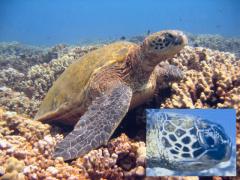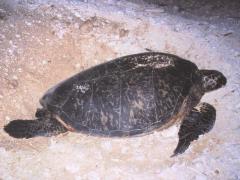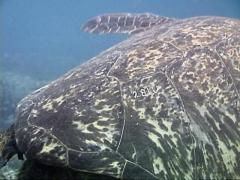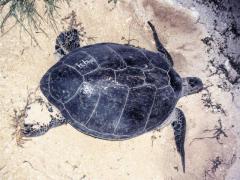Tiamat, a/k/a 4B [1991 Turtle 17]
|
|
That was then (inset, 1993) and this is now (2002).
59K JPEG
|
| Quickstats: Seen 1992, 1993, 1994, 1995 (74K JPG), 1996 (69K JPEG), nesting at French Frigate Shoals 1997, 1998 (50K JPEG), 1999 (76K JPEG), 2000 (70K JPEG), 2001 (55K JPEG), 2002 (59K JPEG), nesting at French Frigate Shoals 2003, 2004. |
Summer updates: 1996, 1997, 1998, 1999, 2000, 2001, 2002, 2003, 2004. |
We first sighted this turtle in 1991. For a long time, she carried a number because of her shy nature. Although she is a 1991 turtle, we did not realize that we had logged her in that year or the next (1992) until we had gotten used to calling her 4B, after her 1993 log number. 4B clearly prefers that people keep their distance. Every summer she lets us get close enough to take her picture, which we do, then we leave her be.
While we have images good enough to make positive identification in 1991, 1992, and 1993, none of them are of high quality. We selected a 1993 image because it was the best choice to illustrate how well the profiles match. The photo, however, offers little hint of the tumors that developed later.
By 1994, this unfortunate animal had numerous tumors over her eyes, neck, throat and shoulders. Tumors were growing at both sides of the mouth. 4B is a large turtle, crowding 100 cm (CCL) and close to breeding size. Tumors showing up on a turtle so close to reproductive size are especially damaging to a threatened species.
There is, however, good news for 1995. She did not appear to worsen in the 10 months between our seasons of '94 and '95. Her eye tumors appeared to have shrunken and her mouth tumors had nearly disappeared. She remained robust and wary but as you can tell from the photograph (74K JPEG), she allows closer approaches now.
We expect to see 4B again in 1996, and we hope the apparent tumor regression will continue. We also are open to the possibility that she might not be around for much of the summer, and that she might appear at the very end of the season sporting shiny new tags. We can hope.
Seeing an old friend for the first time is both exciting and reassuing. 93-4B didn't make us wait long to resight her. We offer our log from that year to demonstrate how delightful our first meeting of 1996 was:
Semi-decent viz with reversa current murking things up.
93-4B shows up right away at 00:00:52--right profile 100% id'd and neck tumors... a shot of left side of 93-4B and can see only one small tumor on left flipper. Eye tumors gone... another regression case! To celebrate will call her Tiamat because of her increased size and girth.
During our months away from the turtles between the Fall of '95 and Spring of '96, we'd been reviewing our tumor statistics and came up with an interesting correlation. We noticed that the all turtles who showed improvement from the disease had names! NAMES!
In 1996 we went about naming a lot of turtles as a kind of protective talisman for the honu we knew lived at Honokowai. We called this turtle Tiamat because this was the name of a dragon (fellow reptiles, after all) and not just any dragon but Queen of the Universe.
Since we'd known her back in 1992, this turtle had become expansive despite her dose of fibropapilloma. Her encouraging improvement in 10 months was startling and Ti' still holds the record for most improved turtle.
We saw her regularly in 1996 and it was clear she'd finally accepted our presence. Previously, she would tolerate us but when she'd eventually go for air, she wouldn't return while we were around.
This summer, Ti' would approach and land while we were at the Turtle House. She still maintained her comfort zone. The few times we invaded this (to take pictures) she'd go for air. The good news is that she'd come back down, a new behaviour. She'd always settle somewhere away from us, though--a strong hint to respect her need for space.
Tiamat is a Honokowai success story. Based on her size and girth, we were already wondering how long it would be before we would not see her. She looked big enough to be a nesting turtle.
We did not have to wait long for the answer.
We did not see Tiamat at all in 1997. We really weren't surprised and it caused us no special worry. After all, Tiamat's condition had improved immensely and she was clearly winning her battle with FP. Since 1992, we had sighted Tiamat regularly at Honokowai--every summer.
We think she spent much of the summer at the French Frigate Shoals making new turtles. Normally, when one of the Honokowai females is missing we contact George Balazs (National Marine Fisheries Service in Honolulu) and give him a tag number. George then confirms the turtle is nesting at the FFS. (So far every tagged female who's gone "missing" at Honokowai has been confirmed to be nesting at the FFS by George Balazs!)
There's a problem with Tiamat however. Ti's a "new nester". She has no tags and so we must wait till the Summer of 1998 when, if the fates are kind, Ti will have returned from her long migration sporting shiny new tags.
We are confident that in 1998 we will read those tags and be able to report to you that Tiamat was at the FFS in 1997. Hawaiian green sea turtles are that reliable.
We sighted Tiamat on our first dive on June 29th and she was immediately tolerant of us. Tiamat was back at her favourite resting place and she was indeed wearing shiny new tags, confirming where she was last summer.
"Ti" sports tags 122C on her left hind flipper and 123C on her right hind
flipper. More exciting, she has "V 40" boldly engraved in the right hind portion of her carapace.
We immediately notified pioneer honu researcher, George Balazs of the National Marine Fisheries Service in Honolulu, that Tiamat had made it safely back to her foraging grounds.
Tiamat's presence at East Island in 1997 put her there exactly in Year 25 of the tagging program started by George. As a result, she is now a really special turtle to us. In 1994, when George Balazs went diving at Honokowai, he met Tiamat. She was very sick with fibropapilloma disease. By 1996, however, she was experiencing regression. Clearly, by 1997 she was healthy enough to make the long migration to the French Frigate Shoals to lay her eggs.
George has estimated that Hawaiian green sea turtles take 25 years to reach maturity. If this is indeed the case, it is possible that Tiamat burst out of the sand as a hatchling back in the summer of 1973 when George first patrolled East Island for nesting sea turtles.
In 1996 we named Tiamat after a dragon in a children's book. Tiamat means "Queen of the Universe". She's certainly Queen of Honokowai!
No surprise. We resighted Tiamat during our first week's diving. Even though she's a mature female, we didn't expect her to be anywhere but Home Sweet Home. After nesting in 1997 she must now build back the pounds and energy to engineer another reproductive effort.
Judging by her girth, things are going well.
It was interesting to observe that while Tiamat's preferred resting spots have always been near the Turtle House, for the first time she'd transferred to set up almost exclusively squatting at our southern Reef 2 location.
What is odd indeed is that Tiamat's new preferred resting place was Ho'olulu's the summer before! We believe Ho'olulu's absence from Honokowai for 1999 can be readily explained. We believe she made her first migration as a new nester.
By filling the hole Ho'olulu left, it's almost as though Tiamat is keeping the other turtle's spot warm and comfy in her absence. "Almost as though..." Fact is we know what really happens.
Once Ho'olulu returns from her first migration to settle into her favourite spot only to find Tiamat planted there, we predict the feathers will fly. Who will be tucked in this coveted piece of real estate in Summer 2000? Tune in next summer, same turtle time, same turtle station.
In our paper, "Home Sweet Home: Aspects of green turtle and hawksbill presence in their feeding, resting and cleaning areas off Honokowai, West Maui, Hawaii (1989-1999)" presented at the 20th Annual Sea Turtle Symposium in Orlando, Florida, we wrote:
"Tiamat, known since 1991, is another example of a long-term resident. We sighted her every summer until 1997, when she made her first migration to the French Frigate Shoals. In the summers of 98 and 99, we saw her daily at Honokowai. We expect her to migrate during Summer 2000."
Indeed she was.
On June 15th, 2000, George Balazs sent us email confirming that Tiamat (tag number 122C) was nesting at East Island, French Frigate Shoals, with two other Honokowai females. George wrote:
As per your message of 23 May, the tags you listed:
A240
122C
U362
All are at East, having a party. Without you. Also without me!
|
|
Tiamat crawled up on East Island and nested on June 22nd
Photo by Vanessa Pepi and Aaron Dietrich
62K JPEG
|
We really didn't expect to see Tiamat until Summer 2001. After all, in 1997 (her first nesting effort) she didn't return in time for us to sight her back at Honokowai--but she surprised us, and in a most wonderful way.
On August 27th George arrived at Honokowai for our end-of-the-summer dive together. The morning dive took us to North House and then to the Turtle House, reserving the second dive for Reef 2.
That afternoon, the three of us were conducting a relaxed survey of Reef 2 when Peter spotted a large turtle with white lettering on her shell. He knew immediately it had to be a female newly returned from French Frigate Shoals. As he approached, the turtle lifted and we immediately recognized her as Tiamat.
Tiamat's mototool marking for the 2000 nesting season
51K JPEG
|
|
The "turf struggle" we anticipated in 1999 might well have occurred, but unfortunately we did not have enough dives left in the summer to find out. Maybe next season...
It didn't take long for Tiamat to make her 2001 appearance. Since we knew that she'd returned safely home from her migration the previous summer, we were confident Tiamat would be at Honokowai.
We sighted our old friend resting with another tagged female (U 249)--two "birds" with one stone since this was the first summer sighting for either turtle. Tiamat looked just fine, healthy and robust.
She was just as standoffish as always. She knows us so she doesn't flee, but she also has zero interest in us. Apparently she has no inclination to interact, and shows nothing resembling curiosity.
Still, we love her. She is one of our fibropapilloma regression cases and as such she's precious and testimony that honu can fight back from the disease and triumph.
With Summer 2001 she has lived at Honokowai for a decade. We first sighted her in 1991 and she's an underwater regular. A regular, that is, unless she's migrating to French Frigate Shoals.
Like the summer before, Tiamat lost no time in showing herself. We joyfully sighted our old friend on our first dive of Summer 2002. She was resting comfortably--and rather massively--at the Reef 2 complex, among other turtles that we've known for years.
"Ti" was around practically every day this summer and so we got lots of "quality time" together. What this really means is that usually, we'd sight her each day, record her presence, and then be on our way. We know Tiamat prefers calm and that means we keep a respectful distance to accommodate her.
She's getting to be a big turtle now, showing that hump on the carapace just to the back of the head. "Adult honu," that says. Her substantial girth in 2002 suggests she'll be making a run for East Island next summer.
We hope so. As always, should she make her migration next summer, George Balazs of the National Marine Fisheries Service will certainly "check in" on her.
We've known Tiamat since she was an adolescent in 1991. Now, eleven summers later, she's still a young maiden by sea turtle standards. We hope that June 2003 sees our special friend patting East Island sand over yet another batch of eggs.
Thanks to George Balazs of the National Marine Fisheries Service, we knew Tiamat's whereabouts this summer. George told us she was off nesting at East Island, French Frigate Shoals. He was kind enough to provide us with a photo of our special honu as well.
|
|
Tiamat doing the motherly thing at East Island.
Photo courtesy George H. Balazs
75K JPEG
|
As far as nesting goes, "Ti" is now unique. She made her first nest in 1997 and by doing that, helped celebrate the 25th summer of tagging begun by George back in 1973. This summer, Ti was back for the 30th anniversary of the same monitoring programme.
We hoped she would arrive home early enough for us to catch a glimpse of her return, but it was not to be. So now we spend ten months in Canada worrying about whether this special wahine made it back home safely.
If the Fates are kind, we expect to see Tiamat on one of our first dives, resting around the turtle tramples of Honokowai's Reef 2.
As expected, we did see Tiamat in our first week of diving in 2004. She looked nice and chunky, and none the worse for wear after her arduous and yes, somewhat risky migration. She's well on the way to fattening up for her next nesting run, which won't be until 2006 if she follows the three-year cycle she has established so far.
While we saw Tiamat frequently hanging around Reef 2 throughout the summer, we did not see her at the north foraging site that we began exploring and documenting this summer. We're not sure why this is, or what this might mean. Our foraging surveys are necessarily limited to the hours just before sunset. Perhaps Tiamat feeds at a different time, during the night or in the early hours of dawn. We know that few turtles feed at the north foraging site around dawn, but Tiamat might be one of them.
Of course, she could be feeding somewhere else entirely. She isn't the only Honokowai regular who doesn't show up at the north foraging site. The possibility of another site intrigues us, and you can bet we'll be trying to find it next summer. With luck, next year we'll be able to tell you where Tiamat gets her dinner!
Last modified 04/11/13
Send comments or corrections to webmaster@turtles.org



